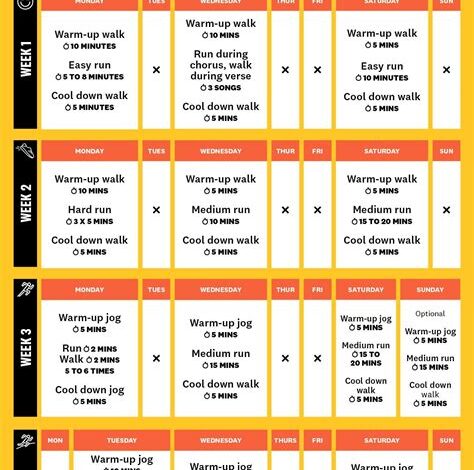How to Start a Running Routine Safely

Get expert tips on assessing fitness level, choosing running shoes, creating a realistic training schedule, proper warm-up and cooling down, and increasing disAre you looking to start a running routine but unsure of where to begin? Running is a fantastic way to stay fit and healthy, but it’s important to approach it safely and smartly to avoid injury and burnout. In this blog post, we will cover all the essential steps to help you start a running routine safely and effectively. From assessing your current fitness level to choosing the right running shoes, creating a realistic training schedule, warming up and cooling down properly, and gradually increasing distance and intensity, we’ve got you covered. By following these tips and guidelines, you’ll be well on your way to embracing a new running routine that will not only benefit your physical health but also your overall wellbeing. So, let’s lace up our running shoes and dive into the world of safe and enjoyable running!
Assessing Your Current Fitness Level
Before starting a running routine, it’s important to assess your current fitness level to avoid injury and set realistic goals. Take stock of your overall health, including any existing medical conditions or injuries that may impact your ability to run. Consult with a healthcare professional to ensure that running is a safe and suitable exercise for you.
Next, evaluate your current level of physical activity. If you’re already consistently active, you may be able to start a running routine more quickly than someone who is starting from a more sedentary lifestyle. Consider factors such as your endurance, strength, and flexibility to gauge where you’re at and where you want to be.
Lastly, assess your mindset and motivation. Starting a running routine requires dedication and self-discipline, so it’s important to be honest with yourself about your commitment level. Set realistic expectations for yourself and recognize that progress takes time.
Choosing the Right Running Shoes
When it comes to starting a running routine, one of the most important decisions you’ll make is choosing the right running shoes. Proper footwear is essential to prevent injury and provide support for your feet, ankles, and knees as you pound the pavement. Make sure to visit a specialty running store where experts can assess your gait and help you find the perfect pair of shoes that fit your individual needs.
It’s important to consider factors such as cushioning, support, and fit when selecting running shoes. Look for a shoe that provides ample cushioning to absorb impact, as well as stability and support that matches your foot and running style. Additionally, consider the fit of the shoe – it should be snug, but not too tight, with enough room in the toe box to allow for natural foot movement while running.
Remember that not all running shoes are created equal, and what works for one person may not work for another. Take the time to try on multiple pairs and test them out by walking and running in the store to ensure they feel comfortable and supportive. Don’t be afraid to ask for assistance from the store staff, as they can provide valuable insights and recommendations based on your specific needs and preferences.
Creating a Realistic Training Schedule
When it comes to starting a running routine, it’s important to create a realistic training schedule that aligns with your fitness level and goals. One of the key factors in creating a realistic training schedule is to assess your current fitness level. This can be done through various fitness tests or by simply evaluating your endurance and stamina during a short run. By understanding where you currently stand in terms of fitness, you can better gauge the intensity and distance that your training schedule should entail.
Another important aspect of creating a realistic training schedule is to gradually increase distance and intensity. It’s essential to start with shorter runs at a comfortable pace and then slowly build up the distance and intensity over time. This gradual progression allows your body to adapt and reduces the risk of injury. It’s also important to warm up and cool down properly before and after each run to prepare your muscles and prevent strain. Including these components in your training schedule will help you maintain a consistent routine and minimize the risk of overexertion.
Choosing the right running shoes is also crucial in creating a realistic training schedule. Proper footwear can significantly impact your performance and overall comfort while running. It’s important to invest in a quality pair of running shoes that provide adequate support and cushioning for your feet. By ensuring that you have the right gear, you can reduce the risk of foot and ankle injuries and make your running experience more enjoyable.
Warming Up and Cooling Down Properly
The title for the blog post: Warming Up and Cooling Down Properly
When it comes to starting a running routine, it’s important to understand the significance of warming up and cooling down properly. Warming up before a run helps to increase blood flow to the muscles, allowing them to work more efficiently. It also loosens the joints and increases the heart rate gradually, preparing the body for physical activity. A proper warm-up can include light jogging, dynamic stretching, or even some simple bodyweight exercises to get the muscles primed for the run.
On the other hand, the cool down is just as important as the warm-up. A proper cool down allows the heart rate to gradually return to its resting state, prevents dizziness or fainting, and helps to remove lactic acid that may have built up in the muscles during the run. It’s a good idea to finish your run with a slow jog or walk, followed by some static stretching to help relax the muscles and improve flexibility.
Warming up and cooling down properly can not only improve overall performance, but also reduce the risk of injury. It’s an essential part of any running routine that should not be overlooked. So, next time you lace up your running shoes, make sure to allocate time for a proper warm-up and cool down to ensure a safe and effective workout.
Gradually Increasing Distance and Intensity
Gradually increasing distance and intensity is a crucial part of starting a running routine safely. It’s important to build up your endurance and strength gradually to avoid overuse injuries and burnout. One way to do this is by following a structured training plan that gradually increases the distance and intensity of your runs over time. This allows your body to adapt and grow stronger, reducing the risk of injury.
Another important aspect of gradually increasing distance and intensity is listening to your body. Pay attention to how you feel during and after your runs, and be willing to adjust your training plan if you start to feel overwhelmed or fatigued. It’s important to strike a balance between pushing yourself to improve and knowing when to take a step back to avoid injury.
One effective way to gradually increase distance and intensity is by incorporating interval training into your routine. This involves alternating between periods of high-intensity running and lower-intensity recovery periods. Interval training can help improve your endurance and speed while reducing the risk of overuse injuries that can come from constantly running at the same pace for long distances.





